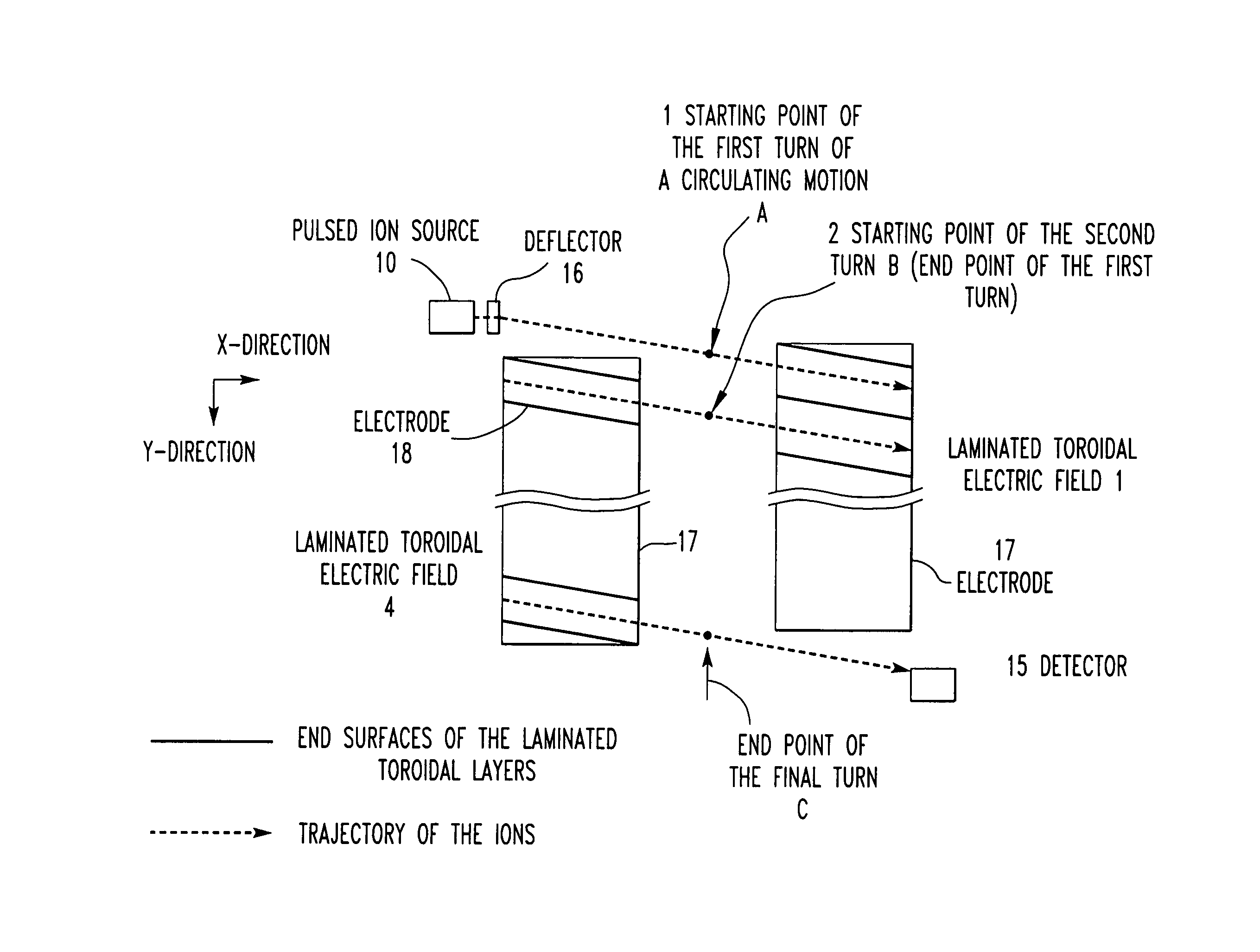Method and apparatus for time-of-flight mass spectrometry
a mass spectrometry and time-of-flight technology, applied in the field of time-of-flight mass spectrometry, can solve the problems of deterioration of sensitivity and mass resolution, deviation of the number of turns at the detected surface from the correct number, and complicated equipment, so as to prolong the flight time and maintain the time focusing properties
- Summary
- Abstract
- Description
- Claims
- Application Information
AI Technical Summary
Benefits of technology
Problems solved by technology
Method used
Image
Examples
fourth embodiment
[0192]FIG. 9 is a diagram illustrating the operation of the fourth embodiment of the present invention. Like components are indicated by like reference numerals in both FIGS. 8 and 9. This embodiment has the configuration shown in FIG. 8. In addition, ions entered from the ion reservoir 32 are further deflected to permit angular adjustment. In the figure, a deflector 50 is mounted to adjust the angle of the entered ions. The deflector operates to match the tilt angle of the ions to the tilt angle of the laminated toroidal electrodes in a case where the tilt angle of the laminated toroidal electrodes is different from the tilt of the ejected ions.
[0193] In the apparatus constructed in this way, ions are created by the continuous ion source 40 and transported into the ion reservoir 32 perpendicularly to the direction of acceleration. The ions stored in the reservoir 32 are applied with a pulsed voltage from the electrodes 30 and 31. At this time, the ions are inevitably traveled obli...
second embodiment
[0200]FIG. 13 is a diagram illustrating a first embodiment of the second aspect of the present invention. Like components are indicated by like reference numerals in both FIGS. 10 and 13. (a) is a view of the apparatus as viewed from the Y-direction. (b) is a view of the apparatus as viewed from the direction of the arrow of the “lower view” in (a). A sample 30 is mixed into a matrix (such as liquid or crystalline compound or metal powder), dissolved, solidified, and placed onto a sample plate 20 (see FIG. 11). A lens 2, a mirror 25, and a CCD camera 27 are disposed to permit observation of the state of the sample 30.
[0201] Laser light is directed at the sample 30 via the lens 1 and mirror 24 to vaporize or ionize the sample. The generated ions are accelerated by the voltage applied to the accelerating electrodes 21 and 22 and introduced into a helical-trajectory TOF-MS. In a general TOF-MS, it is necessary that the produced ions be pulsed by a pulsed voltage for measurement of fli...
PUM
 Login to View More
Login to View More Abstract
Description
Claims
Application Information
 Login to View More
Login to View More - R&D
- Intellectual Property
- Life Sciences
- Materials
- Tech Scout
- Unparalleled Data Quality
- Higher Quality Content
- 60% Fewer Hallucinations
Browse by: Latest US Patents, China's latest patents, Technical Efficacy Thesaurus, Application Domain, Technology Topic, Popular Technical Reports.
© 2025 PatSnap. All rights reserved.Legal|Privacy policy|Modern Slavery Act Transparency Statement|Sitemap|About US| Contact US: help@patsnap.com



